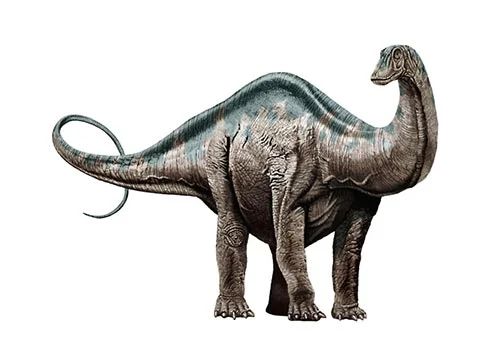Apatosaurus (Deceptive lizard)

A-pat-oh-sore-us
Othniel Charles Marsh - 1877
Herbivore
Estimated 20-23 meters long
Sauropod
A. ajax (type), A. louisae
USA, Colorado, Oklahoma, Utah and Wyoming
Late Jurassic, 154-145 million years ago
Apatosaurus Facts
Apatatosaurus (/@,paet@’so:r@s) is an herbivore sauropod genus that was found throughout North America during the Late Jurassic period. It was alive from 150 to 150 million years ago (mya) in the latter part of Kimmeridgian to the early Tithonian time period and is currently recognized as fossils from the Morrison Formation of modern-day Colorado, Oklahoma, New Mexico, Wyoming, and Utah in the United States.
It had an average length of 21-22.8 meters (69-75 feet) and an average weight of 16.4-22.4 tons (16.1-22.0 large tons, 18.1-24.7 shorter tons). A few of the specimens suggest a length of 11-30% more than the average, and a weight in the range of 32.7-72.6 tonnes (32.2-71.5 tonnes long; 36.0-80.0 short tons).
Its cervical vertebrae are not as long and are more robustly constructed than those of Diplodocus diplodocid similar to Apatosaurus while the bones in the leg appear bigger despite being larger which suggests it was a stronger animal.
Its tail was elevated in the air when it was moving and it was equipped with a single claw for each forelimb as well as 3 claws on the hindlimbs. Its skull was mistaken for that from Camarasaurus or Brachiosaurus until 1909 when the holotype of A. louisae was discovered. Apatosaurus is one of the genera that belongs to the family of Diplodocidae. It is among the most basal genera with just Amphicoelias and perhaps a new unnamed genus that is more primitive.
It was present throughout North America during the late Jurassic and would have been a part of dinosaurs like Allosaurus, Camarasaurus, Diplodocus and Stegosaurus. It was a huge long-necked, quadrupedal creature with a whip-like tail.
The majority of estimates of size are based on CM 3018, which is the type one from A. Louisae. It is estimated that the current estimates are similar in that the individual was 21-22.8 meters (69-75 feet) tall and weighed the weight that was 16.4-22.4 tonnes (16.1-22.0 length tons and 18.1-24.7 short tons).
A study from 2015 that calculated the volumetric model’s mass of Dreadnoughtus Apatosaurus as well as Giraffatitan estimates CM 3018’s mass at 21.8-38.2 tons (21.5-37.6 tonnes long; 24.0-42.1 shorter tons). A few samples of A. Ajax (such as OMNH 1670) are also known.
Apatatosaurus is a diplodocid with a small skull, lined Spatulate (chisel-like) teeth, and a large snout. Its neck vertebrae are deep bifurcated and surrounded by an enormous trough at the middle, resulting in a large deep neck.
The vertebral formula used for the Holotype of A. louisae may be 15 cervicals 10 dorsals 5 sacrals with 82 caudals. The teeth with the enamel exposed do not exhibit any marks on the surface and show a sweet texture with a very little wear.
The neck’s large size was full of a large system of air sacs to help with weight. Apatosaurus as well as its close cousin Supersaurus has high neural spines, which comprise over half of the bones that make up its vertebrae. The tail is comparatively thin due to the declining height of the vertebral column.



